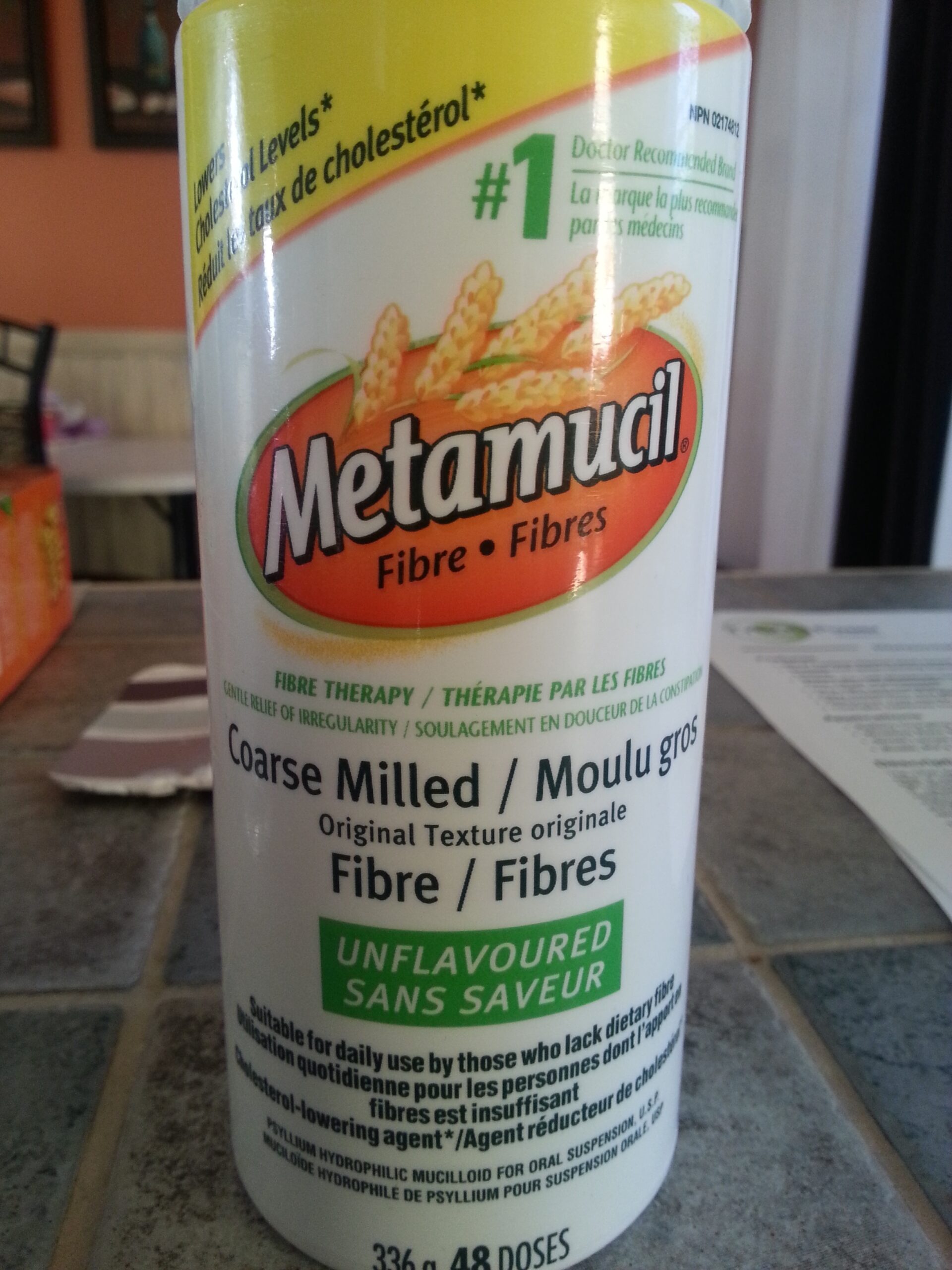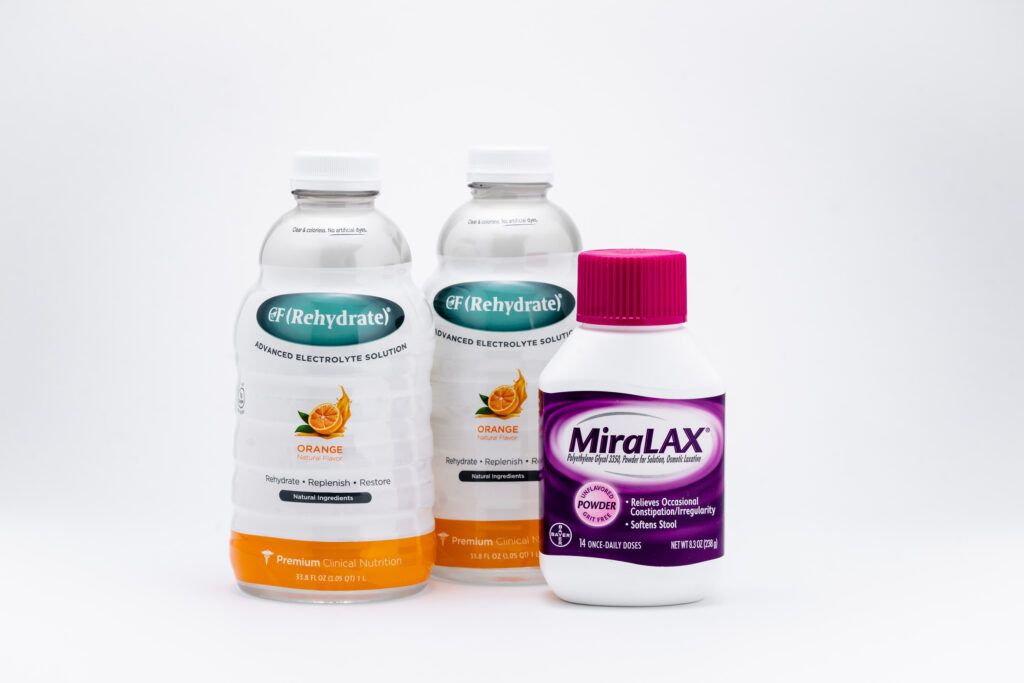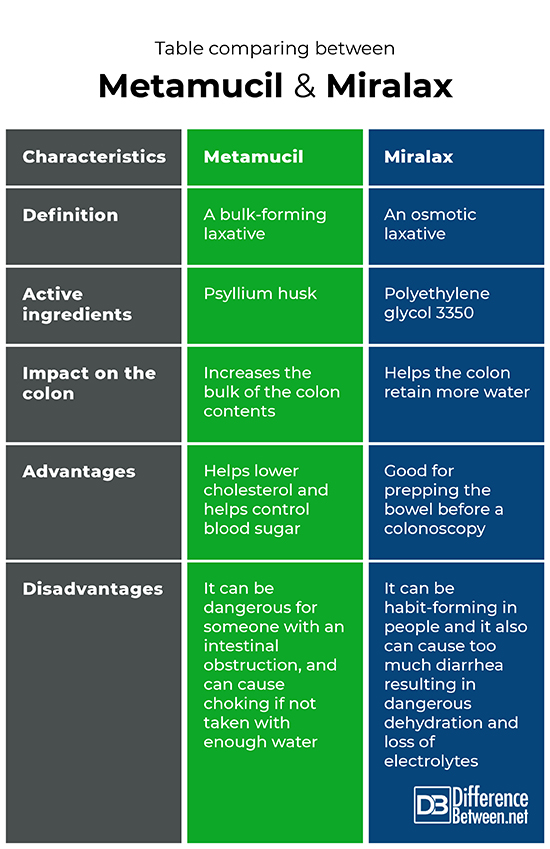Difference Between Metamucil and Miralax
• Categorized under Health,Science | Difference Between Metamucil and Miralax
Metamucil is a bulk-forming laxative containing Psyllium fiber. Miralax is an osmotic laxative containing polyethylene glycol 3350.

What is Metamucil?
Definition:
Metamucil is a type of laxative that contains Psyllium fiber that works by increasing the bulk of the bowel contents.
Ingredients and how you take it:
The primary ingredient of Metamucil is Psyllium husk, which is extracted from the plant Plantago ovata. Metamucil can be taken as a capsule or as a powder that is added to water.
How it works:
The Psyllium in Metamucil increases the volume of contents in the colon, making it more likely for the person to have a bowel movement. Studies indicated a change from 372 mL up to 578 mL for people who took Metamucil. The same study also indicated an increase in the amount of water in the colon after eating when a person took Metamucil compared with the control. The increased water content as well as increased bulk makes the stool softer and thus easier for a constipated person to pass.
Uses:
Metamucil contain a form of fiber used to treat people who suffer from occasional constipation. This laxative usually results in a bowel movement anywhere between 12 hrs. to about 72 hrs.
Advantages:
Studies have shown that not only is it useful for treating constipation, but there is also some benefit for people who also have high cholesterol in that the Psyllium in Metamucil does lower cholesterol, possibly by affecting bile salt reabsorption. Research has also shown promising results when it comes to blood sugar control, with Psyllium helping people who have type 2 diabetes.
Disadvantages:
Due to how the fiber works in the gut, it may be risky for a person with a history of bowel obstruction to use this type of laxative. It also needs to be taken with enough water so as not to cause choking since the Psyllium swells up once in contact with fluid. This means that choking can occur if it lodges in the throat. Metamucil is often not a good choice where a person has slow colonic transit and it can cause loss of appetite and a delay in stomach emptying.

What is Miralax?
Definition:
Miralax is an osmotic laxative which contains a substance called polyethylene glycol 3350, abbreviated as PEG.
Ingredients and how you take it:
The primary ingredient of Miralax is the chemical substance polyethylene glycol 3350. This is a synthetic substance that is made in a lab. Miralax occurs in the form of a powder that you add to a drink.
How it works:
It helps the colon to retain water making the stool softer and easier to pass. The way it works can be confused with Metamucil but the difference is that Miralax does not swell up and increase bulk; it simply affects the water content, which causes bowel movements to occur more often. The actual mechanism is based on osmosis with the PEG attracting water into the colon causing the stool to soften.
Uses:
Miralax is useful in treating temporary short-term constipation, and has been shown to increase the frequency of bowel movements; research showed people having 4.5 bowel movements per week versus 2.7 in the control group. It is also used as bowel prep for people needing to have a colonoscopy.
Advantages:
It can be very effective in cleaning the bowel out for somebody who needs to have a colonoscopy. It is effective in relieving constipation.
Disadvantages:
A person can suffer severe diarrhea in some cases when taking Miralax and it can be habit-forming, which means it cannot be taken too often. Severe diarrhea due to laxative use can be dangerous because it can cause dehydration and a loss of electrolytes from the body.
Difference between Metamucil and Miralax?
Definition
Metamucil is a bulk-forming laxative. Miralax is an osmotic laxative.
Active ingredients
The active ingredient of Metamucil is Psyllium husk which is a type of fiber. The active ingredient of Miralax is Polyethylene glycol 3350, a synthetic substance.
Impact on the colon
Metamucil absorbs water and swells up causing the bowel contents to become larger. Miralax helps water be retained in the colon making bowel movements easier as the stool is softer.
Advantages
Metamucil also helps lower cholesterol and helps control blood sugar. Miralax works well for cleaning out the bowel before a colonoscopy procedure.
Disadvantages
A disadvantage of Metamucil is that it can be dangerous for someone with an intestinal obstruction, and can cause choking if not taken with enough water. A disadvantage of Miralax is can be habit-forming in people and it also can cause too much diarrhea resulting in dangerous dehydration.
Table comparing between Metamucil and Miralax

Summary of Metamucil Vs. Miralax
- Both Metamucil and Miralax are medications that are used to treat people who are constipated.
- Both Metamucil and Miralax are substances that help treat constipation.
- Metamucil works by having fiber that absorbs water and causes the contents of the colon to bulk up.
- Miralax affects water in the colon, making the stool softer and easier to pass.
- Difference Between Rumination and Regurgitation - June 13, 2024
- Difference Between Pyelectasis and Hydronephrosis - June 4, 2024
- Difference Between Cellulitis and Erysipelas - June 1, 2024
Sharing is caring!
Search DifferenceBetween.net :
Cite
APA 7
Osborn, D. (2021, November 23). Difference Between Metamucil and Miralax. Difference Between Similar Terms and Objects. https://www.differencebetween.net/science/health/difference-between-metamucil-and-miralax/.
MLA 8
Osborn, Dr. Rae. "Difference Between Metamucil and Miralax." Difference Between Similar Terms and Objects, 23 November, 2021, https://www.differencebetween.net/science/health/difference-between-metamucil-and-miralax/.
Leave a Response
Written by : Dr. Rae Osborn. and updated on 2021, November 23
References :
[0]DiPalma, Jack A., et al. "A randomized, placebo-controlled, multicenter study of the safety and efficacy of a new polyethylene glycol laxative." The American journal of gastroenterology 95.2 (2000): 446-450.
[1]Major, Giles, et al. "Demonstration of differences in colonic volumes, transit, chyme consistency, and response to psyllium between healthy and constipated subjects using magnetic resonance imaging." Neurogastroenterology & Motility 30.9 (2018): e13400.
[2]Moreyra, Abel E., Alan C. Wilson, and Ashraf Koraym. "Effect of combining psyllium fiber with simvastatin in lowering cholesterol." Archives of internal medicine 165.10 (2005): 1161-1166.
[3]Image credit: https://drinkclearfast.com/wp-content/uploads/2020/06/0022-1024x683.jpg
[4]Image credit: https://static.openfoodfacts.org/images/products/003/700/030/8539/front_en.3.full.jpg
See more about : Metamucil, Miralax
